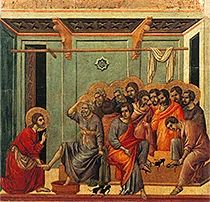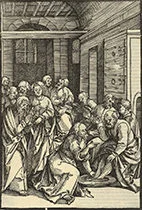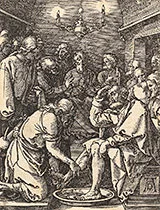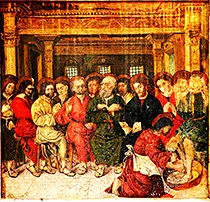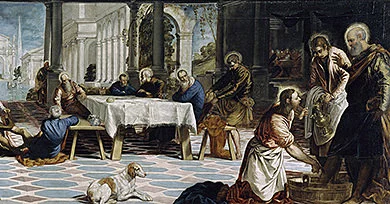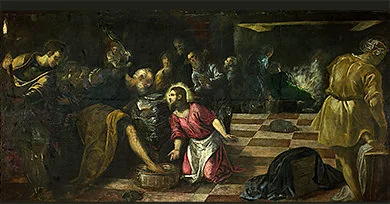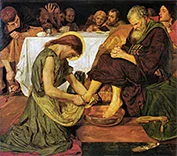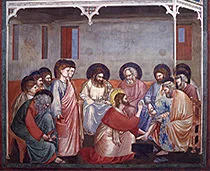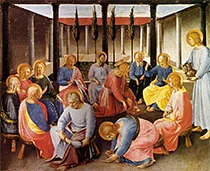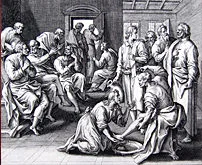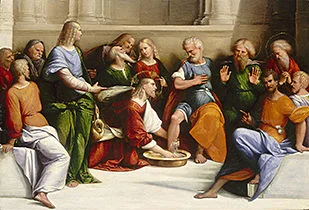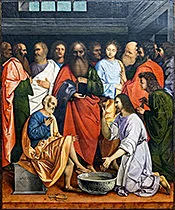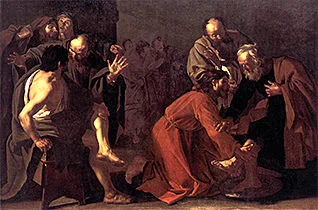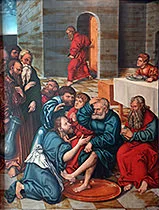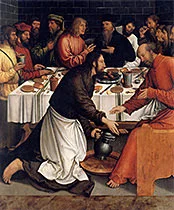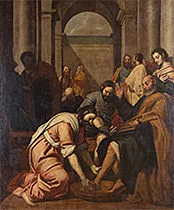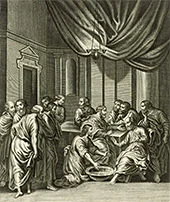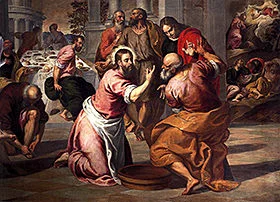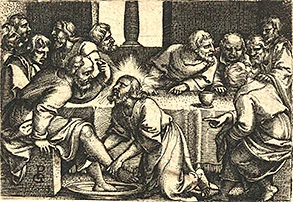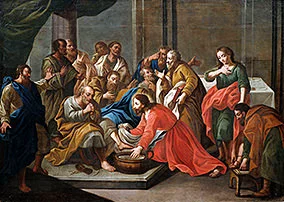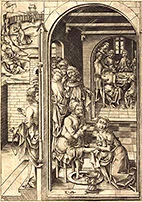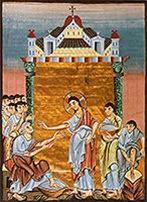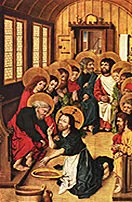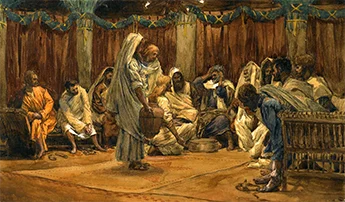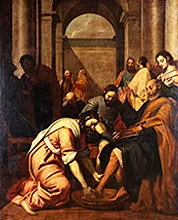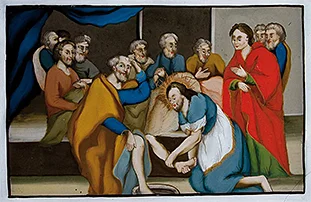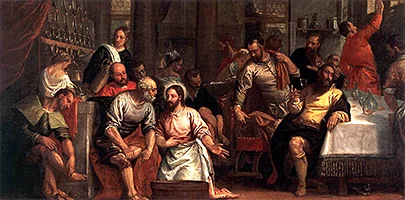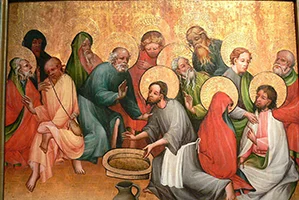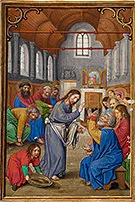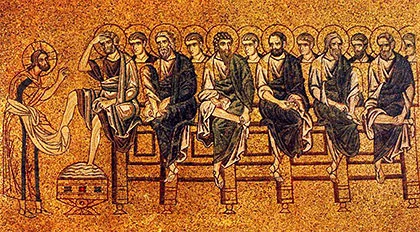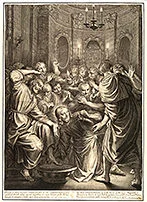The Art World Commemorates Peter
— Album 8 of 17 Photo Albums —
Warren Camp’s presentation of 550 famous “Peter” works of art includes historic paintings, frescoes, stained glass, etchings, sculptures, engravings, and other artwork monuments. They come from the Gothic (1100–1400), High Renaissance, Baroque, Rococo, Neoclassical, and Romantic (1800s) eras.
All are popular works, designed and created by celebrated artists, many of whom you’ll likely recognize, including Rembrandt, Raphael, Michelangelo, El Greco, Da Vinci, Masaccio, Huret, Galle, Tissot, Botticelli, Dürer, Rubens, and many more. They’ll bring back recollections of your “Art History 101” classes, using Janson’s History of Art textbook.
Whether depicting “Cephas,” “Petrus,” “Simon,” “Simeon,” “Simon Bar-Jonah,” “Simon Peter,” “The Rock,” “Peter,” “Apostle Peter,” or “Saint Peter,” the enlarged images of this acclaimed Bible figure come with factual and enlightening details: the artist’s bio; when each work was created; where it can be seen; applicable Bible passages; background and highlights of each work; and photo sources with copyright notices.
To appreciate the impact that Peter had on numerous art-world masters, be sure to click each thumbnail to enlarge it.
• These photo albums complement the Bible-study commentaries Warren has written for “1st and 2nd Peter,” found here.
…
Album 1 (Peter, alone) | Album 2 | Album 3 | Album 4 | Album 5
Album 6 | Album 7 | Album 8 | Album 9 | Album 10 | Album 11
Album 12 | Album 13 | Album 14 | Album 15 | Album 16 | Album 17
Album topics are shown at the [ ⇓ bottom ⇓ ] of each page.
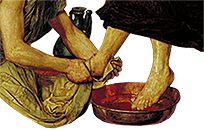
Jesus Washes Peter’s Feet
Slide 5
Click to enlarge.
Jacopo Tintoretto — c. 1548, oil on canvas
Slide 6
Click to enlarge.
Jacopo Tintoretto — 1575–1580, oil on canvas
Resurrection of Christ”
Slide 10
Click to enlarge.
Collaert — c. 1598
engraved print
Slide 11
Click to enlarge.
Benvenuto Tisi — 1520–1525
oil on panel
the Feet of the Apostles”
Slide 12
Click to enlarge.
Giovanni Agostino da Lodi
1500, oil on panel
Slide 13
Click to enlarge.
Dirck van Baburen — c. 1616
oil on canvas
Feet of the Apostles”
Slide 17
Click to enlarge.
Adriaen Lommelin
1654–1673, engraving
Washing of His Feet”
Slide 19
Click to enlarge.
Georg Pencz — 1535–1537, engraving
Slide 21
Click to enlarge.
Israhel van Meckenem — c. 1480
engraving
Slide 22
Click to enlarge.
unnamed artist — 10th–11th cent.
oil on canvas
Slide 23
Click to enlarge.
Housebook Master — c. 1480
oil and tempera on wood
Slide 24
Click to enlarge.
James Tissot
1886–1894
watercolor on gray paper
Slide 27
Click to enlarge.
Paolo Veronese — 1580s — oil on canvas
Slide 28
Click to enlarge.
unknown artist — c. 1410 — altarpiece painting
the Apostles’ Feet”
Slide 29
Click to enlarge.
Simon Bening
c. 1525–1530
tempera on paper
Slide 30
Click to enlarge.
unknown artist — Byzantine mosaic — c. 1210
- 1. “The Washing of the Feet (scene 2, Maestà),” tempera on panel, painted by Duccio di Buoninsegna, 1308–1311
Duccio di Buoninsegna (1255–1319) “was the first great Sienese painter. In 1308, he achieved the consummation of his career with the contract for the huge Maestà for the High Altar of Sienna Cathedral. The work was finished in 1311 and carried in a solemn procession from his workshop to the Cathedral. Most of it is still in Siena Cathedral Museum.”[1] “The picture shows one of the twenty-six narrative scenes from the Stories of the Passion on the reverse side of the Maestà (which Warren Camp highlights in Album 15 of this ‘Peter Masterpieces’ photo album. And to see many more of Duccio’s Maestà creations that feature Peter, open Warren Camp’s Albums #2, 4, 8, 9, 13, 14, and 15). Only gospel-writer John tells the humble story of The Washing of the Feet. Echoes from Byzantine art can be seen in the crowded throng of the apostles and Peter’s gesture, while Christ’s position recalls Western models. The shape of the black sandals, aptly described by Cesare Brandi, ‘as if they were precious onyx scarabs,’ is typical.”[2]
“The story of Jesus washing the feet of his disciples presents us with two responses to God’s eternally offered invitation. Jesus offers this amazing gift of himself to all twelve disciples, but one chooses to reject it; Judas, as Jesus already knew, had determined to betray him. The text implies that Jesus washed Judas’ feet even though he knew what Judas would do. But clearly, Judas did not accept Jesus’ offer of intimacy. He turned away from Jesus and chose death. Peter, in contrast, opened himself to accept Jesus’ offer; with exuberance and abandon he asked that not only his feet be washed but the rest of him also. Jesus kneels before Peter in a moment of physical intimacy as he holds Peter’s foot as he woos him into a closer union.”[3]
… Height: 19.7 in. (50 cm), width: 20.9 in. (53 cm)
… Photo source, license, attribution, and image enlargement: public domain, via Web Gallery of Art; Museo dell'Opera del Duomo, Siena
… The artist’s short biography; his other works of art.
Return to “Peter Masterpieces” album’s opening page or to the top of this page or open the next album. - 2. “Christ Washing Saint Peter’s Feet,” woodcut print by Hans Schäufelein, 1507
Hans Schäufelein (c. 1480–c. 1540), “a German painter and designer of woodcuts and glass-paintings, was strongly influenced by Albrecht Dürer.”[1] Dürer’s influence is evident in Schäufelein’s earliest graphic works, his woodcuts, as featured above in this Christ Washing Saint Peter’s Feet, from “The Mirror of the Passion of Our Lord Jesus Christ” shown by the Library of Congress. Interestingly, in Schäufelein’ depiction of the foot-washing event, although Jesus bent over the dirty feet of Judas Iscariot and washed them with water and wiped them with a towel, he presents only eleven disciples.
“Jesus washing His disciples’ feet (John 13:1–17) occurred in the upper room (a.k.a. the ‘Cenacle,’) during the Last Supper, It’s significant in three ways: For Jesus, it was the display of His humility and His servanthood; for the disciples, the washing of their feet was in direct contrast to their heart attitudes at that time; for us, washing feet is symbolic of our role in the body of Christ.“Walking in sandals on first-century Israel’s filthy roads made it imperative to wash feet before a communal meal, especially since people reclined at a low table and feet were evident. When Jesus rose from the table and began to wash the disciples’ feet (John 13:4–5), He was doing the work of a servant. The disciples must have been stunned at His act of humility and condescension, that Christ, their Lord and master, should wash the feet of His disciples, when it was their proper work to have washed His.”[2] The essential lesson Jesus has taught the church, therefore, is to humbly, lovingly, and sacrificially serve other people.
… Height: 9 1/2 in. (24.1 cm), width: 6 3/8 in. (16.2 cm)
… Photo source, license, attribution, museum details, and image enlargement: The Met; Gift of Junius S. Morgan, 1919
… The artist’s short biography; his other works of art.
Return to “Peter Masterpieces” album’s opening page or to the top of this page or open the next album. - 3. “Christ Washing the Feet of the Disciples,” woodcut print by Albrecht Dürer, c. 1508
German artist Albrecht Dürer’s “Christ Washing the Feet of the Disciples” is from his Small Passion woodcuts collection. In the late 15th and early 16th centuries, Dürer’s extensive work in printmaking helped transform the medium into a fine art form. His woodcuts, etchings, engravings, drawings, and paintings focus largely on religious iconography. He’s considered one of the greatest artists to emerge from the Renaissance. This work is monogrammed “AD” on the side of the bench, lower-right.
In this touching image, Dürer captures Apostle Peter’s immense devotion to Christ who demonstrates affectionately to Peter that he’s worthy of Christ’s love and respect. Peter’s contemplative pose, with his finger atop his head while having his feet washed by his Lord, calls to mind the apostle’s follow-up pronouncement, “…wash…not just my feet but my hands and my head as well!” (John 13:8–11).
What happened in the upper room during the Last Supper? The events that occurred in the upper room, relating to Jesus washing his disciples’ feet, are described in John 13:1–38. During the last hours that Jesus spent with his beloved friends, he washed their feet, ate supper with them, instituted the New Covenant in his blood, gave them last-minute instructions with encouragement, and prayed a “high priestly prayer” over them. Warren Camp compiled this list of twenty-one sequential events surrounding the Last Supper event, from foot washing to departing the upper room.
… Height: 5 1/16 in. (12.8 cm), width: 3 7/8 in. (9.8 cm)
… Photo source, license, attribution, museum details, and image enlargement: The Met; the George Khuner Collection, Gift of Mrs. George Khuner, 1975
… The artist’s short biography; his other works of art; Dürer’s collection of thirty-six “Small Passion” woodcuts and twelve “Large Passion” woodcuts
Return to “Peter Masterpieces” album’s opening page or to the top of this page or open the next album. - 4. “Jesus Washing the Feet of His Apostles,” altarpiece painting by Antoine Ronzen, 1520
Antoine Ronzen’s “Jesus Washing the Feet of His Apostles” is a painted medallion panel. “This altarpiece of the Passion, located in France’s Basilica of Sainte-Marie-Madeleine in Saint-Maximin in the Var department, was created in 1520 by Ronzen with the collaboration of Antoine Brea. These are paintings on wood, recalling all the scenes of Christ’s passion, presented in eighteen medallions grouped around a large central painting of the crucifixion.”[1] See the entire altarpiece and each individual Passion panel. This panel is shown in this diagram’s Location 1.
Selfless Service In one memorable example, Jesus set aside his own concerns to wash the disciples’ feet during the Last Supper. He knew he’d soon face intense physical, mental, and emotional distress. Despite this burden, he considered what his followers needed most and taught them an important lesson. As Christ prepared to wash their feet, he shed his right to be served as easily as he took off his outer garment (John 13:4). Despite being the most important person present, he gave up his rights, kneeling down to clean their feet. Clearly, servanthood is most meaningful when we leave our selves behind.
Apostle John tells us this about Jesus’ humble act of washing his apostle’s feet: “During supper, when the devil had already put it into the heart of Judas Iscariot, Simon’s son, to betray him, Jesus, knowing that the Father had given all things into his hands, and that he had come from God and was going back to God, rose from supper. He laid aside his outer garments, and taking a towel, tied it around his waist. Then he poured water into a basin and began to wash the disciples’ feet and to wipe them with the towel that was wrapped around him” (John 13:2–5). How significant was Jesus’ act! After all, washing a person’s feet wasn’t only demeaning, the Jews saw it as being an especially disdainful act. Surprisingly, Jesus took on the foot-washing role, after first removing his outer garments and wrapping a towel around his waist, resembling a common slave. It must have been an extremely awkward moment for Judas, “For Jesus knew who was to betray him; that was why he said, ‘Not all of you are clean’” (13:11).
… Height: 7 ft. 7 in. (232 cm), width: 7 ft. 2 in. (220 cm)
… Photo source, license, attribution, museum details, and image enlargement: Rvalette, CC BY-SA 3.0, via Wikimedia CommonsReturn to “Peter Masterpieces” album’s opening page or to the top of this page or open the next album.
- 5. “Christ Washing the Disciples’ Feet,” oil on canvas, painted by Jacopo Tintoretto, 1548–1549
“Christ Washing the Disciples’ Feet” was a favorite theme of Tintoretto. “There are at least six known works by him on the subject that comes from a passage in John 13:1–11 where, prior to the Last Supper event, Christ washes the feet of his disciples. This Scripture called for a complex image with many characters in a variety of poses and motions; its diversity and challenge attracted Tintoretto. This painting was created in 1548/1549 for the church of San Marcuola in Venice, which commissioned this painting as a companion piece to Tintoretto’s “Last Supper,” which still hangs at San Marcuola.”[1] Note: You can see and learn about that other Tintoretto “Last Supper” paintings in Warren Camp’s Album 10 [slides 3-–33] of his “Peter Masterpieces” artwork photo album. The next slide presents a later Tintoretto version of “Christ Washing the Feet of the Disciples” painting, which is very different.
“Typical of Tintoretto, throughout his career, is the dramatic setting for this scene: the long diagonal vistas serving to transform the humble event into an apocalyptic vision. The coloring, however, is bright and sumptuous, the modeling is firm, and the space and light are clear and still — a sign of the fairly early date of the work in the artist’s career.”[2] Watch this excellent, informative narrated video highlighting Tintoretto’s foot-washing masterpiece.
• Dog lovers: Tintoretto copied the animal in this foreground from a 1546 painting by Jacopo Bassano [shown in Camp’s Album 11, slide 23].
… Height: 7 ft. 6 in. (228 cm), width: 17 ft. 6 in. (533 cm)
… Photo source, license, attribution, and image enlargement: Wikimedia Commons; Museo del Prado
… The artist’s short biography; his other works of art
Return to “Peter Masterpieces” album’s opening page or to the top of this page or open the next album. - 6. “Christ Washing the Feet of the Disciples,” oil on canvas, painted by Jacopo Tintoretto, c. 1575–c. 1580
This “Christ Washing the Feet of the Disciples” oil-on-canvas painting by Tintoretto differs significantly from his earlier painting [see previous slide]. His depiction of the preliminary scene of the Last Supper is part of London’s National Gallery collection. Dating c. 1575–1580, it was commissioned for Venice’s church of San Trovaso. Both of his foot-washing paintings were paired with a Last Supper painting of his. Much more intimate than his previous slide’s painting, the above painting is set in a smaller room with a dining table and an untraditional fireplace. Christ, kneeling in the center, washes Peter’s feet while the other disciples gather around attentively. Scripturally, the foot-washing episode illustrates the need for self-abasement and fraternal love.
Selfless Service In one memorable example, Jesus set aside his own concerns to wash the disciples’ feet during the Last Supper. He knew he’d soon face intense physical, mental, and emotional distress. Despite this burden, he considered what his followers needed most and taught them an important lesson. As Christ prepared to wash their feet, he shed his right to be served as easily as he took off his outer garment (John 13:4). Despite being the most important person present, he gave up his rights, kneeling down to clean their feet. Clearly, servanthood is most meaningful when we leave our selves behind.
The foot-washing scene comes from a passage in John 13:1–17, prior to the Last Supper event. “He rose and began to wash their feet. Peter said he could not allow this, but Christ replied that, if Peter would not allow him to wash his feet, he had no place with him. Peter asked Christ to wash his hands and head as well, but Christ said that those who were clean needed only to have their feet washed. He then instructed the disciples to wash one another’s feet.”[1]
… Height: 6 ft. 8 in. (204.5 cm), width: 13 ft. 6 in. (410.2 cm)
… Photo source, license, attribution, and image enlargement: Tintoretto, public domain, via Wikimedia Commons; The National Gallery
… The artist’s short biography; his other works of artReturn to “Peter Masterpieces” album’s opening page or to the top of this page or open the next album.
- 7. “Jesus Washing Peter’s Feet,” oil on canvas, painted by Ford Madox Brown, 1852–1856
Born in France, Ford Madox Brown (1821 to 1893) was a British painter. “This picture illustrates the biblical story of Christ washing his disciples’ feet at the Last Supper. It has an unusually low viewpoint and compressed space. Critics objected to the picture’s coarseness – it originally depicted Jesus only semi-clad. This caused an outcry when it was first exhibited and it remained unsold for several years until Ford Madox Brown reworked the figure in robes.”[1]
We find the foot-washing scene in a passage in John 13:1–17 wherein, prior to the Last Supper event, Christ washes his disciples’ feet. He’d ended his public ministry and ministered privately to his disciples during his last few hours with them before his crucifixion. His surprising act has great significance, since it would have been demeaning for anyone but a slave or household servant to wash someone’s feet. And the Jewish nation considered foot-washing to be condescending. Nevertheless, Christ wrapped a towel around his waste and played the self-abasing role of slave.
All twelve apostles don't appear herein. Brown does include Judas Iscariot, sitting head-down at the left end of the dining table keeping his coin purse close. What was going through his mind seeing Jesus kneeling, rendering unto Peter the service of a foot-washing slave? Judas first heard Jesus say, “And you are clean, though not every one of you (v. 10b).” Jesus later said, “Now that I, your Lord and Teacher, have washed your feet, you also should wash one another’s feet” (v. 14), teaching his church body to wash one another’s feet; in essence, to sacrificially serve others — even when it might appear beneath us to serve others in that way.
… Height: 45.9 in. (116.8 cm), width: 52.4 in. (133.3 cm)
… Photo source, license, attribution, and image enlargement: Ford Madox Brown, public domain, via Wikimedia Commons; Tate Gallery
… The artist’s short biography; his other works of art
Return to “Peter Masterpieces” album’s opening page or to the top of this page or open the next album. - 8. “Washing of Feet,” fresco, painted by Giotto di Bondone, 1304–1306
Giotto di Bondone (1266–1337), known mononymously as Giotto, was an Italian painter and architect from Florence during the Late Middle Ages. He worked during the Gothic/Proto-Renaissance period (1300–1425).[1] This “Washing of Feet” fresco painting is scene 14 of the thirty-seven scenes he painted in his “Life of Christ” series. The fresco cycle is regarded as one of the supreme masterpieces of the Early Renaissance.
Giotto has given each of the Twelve a dark halo while the kneeling Christ wears a golden halo. Front-left, Andrew sits fastening his left sandal; front-right, Peter looks inquisitively at Jesus who lifts his right hand upwards towards Peter while holding Peter’s leg with his other hand. Two unbearded apostles stand behind Jesus, holding a jug of water; the remaining seven apostles sit on benches. Peter, lifting up his blue robe to keep it dry, scratches his head with his right hand, totally unsure of Jesus’ foot-washing effort and confused after hearing Jesus tell him, “Unless I wash you, you have no part with me” (John 13:8b).
Here are the Scriptures that document details of the Last Supper: Matt. 26:17–30, Mark 14:12–32; Luke 22:7–38; John 13:2–38. See Warren Camp’s accurate compilation of twenty-one sequential events leading up to and following the Last Supper. Each event, such as “Jesus Washes His Disciples’ Feet,” “Judas Identified as the Betrayer,” and “Departing the Upper Room,” is presented in the order in which it occurred; links to specific Bible references are included.
… Height: 6 ft. 6 in. (200 cm), width: 6 ft. 0 in. (185 cm)
… Photo source, license, attribution, and image enlargement: public domain, via Web Gallery of Art; Cappella Scrovegni (Arena Chapel), Padua, Italy
… The artist’s short biography; his other works of art
Return to “Peter Masterpieces” album’s opening page or to the top of this page or open the next album. - 9. “The Washing of the Feet,” tempera on wood, painted by Fra Angelico, 1451–1452
Fra Angelico (c. 1395 to 1455) “was commissioned for a massive painted cabinet to protect the precious silver votive offerings at Santissima Annunziata, among the most venerable churches in Florence. The Armadio degli Argenti (Silver Chest) may have been the most visible of the friar’s work. His series depicting scenes from the life of Christ consisted of forty paintings of equal size (38.5 x 37 cm) and one additional double-sized painting. From the forty-one paintings, six were lost during the centuries. From the thirty-five paintings kept in the Museo di San Marco, Florence, three can be attributed to Baldovinetti while the others are the work of Fra Angelico.”[1]
This “Washing of the Feet” painting was completed in 1452. “The twelve scenes painted on the panel that includes this painting include: ‘Raising of Lazarus,’ ‘Entry into Jerusalem,’ ‘The Last Supper,’ ‘Payment of Judas,’ ‘The Washing of the Feet,’ ‘Institution of the Eucharist,’ ‘Prayer in the Garden,’ ‘Judas’ Betrayal,’ ‘Capture of Christ,’ ‘Christ before Caiafas,’ ‘Mocking of Christ,’ and ‘Christ at the Column.’”[2]
Herein, Jesus, in red, in the center of the circle formed by his apostles, is about to wash the feet of his disciples. On one knee, he faces Peter, wearing a blue-and-yellow tunic. Peter’s hands-raised gesture shows his discomfort and disagreement with Jesus who insisted on washing Peter’s feet. The barefoot apostle standing right is ready to bring the water to Jesus. At the left, the apostle wearing a dark tunic might be Judas.
… Height: 15 in. (38.5 cm), width: 14 in. (37 cm)
… Photo source, license, attribution, and image enlargement: public domain, via Web Gallery of Art; Museo di San Marco, Florence
… The artist’s short biography; his other works of art
Return to “Peter Masterpieces” album’s opening page or to the top of this page or open the next album. - 10. “Christ Washing the Feet of Saint Peter,” Plate 35, engraved by Adriaen Collaert, c. 1598, after Maarten de Vos
Adriaen Collaert (1560–1618) was a Flemish designer, engraver, and pupil of Pieter de Vos. “A member of a family of reproductive engravers working in Antwerp during the 16th and 17th centuries, Collaert was a print publisher, book illustrator, and reproductive engraver.”[1]
In this engraved print, plate 35, Collaert places haloed Christ, front and center of this masterpiece that presents thirteen men in the room; Judas is not easily identifiable. Jesus, kneeling in front of Apostle Peter, prepares to wash his feet. All the others had already removed their sandals and were ready for their foot-washing. With his right hand raised in protest, Peter told Jesus that he couldn’t allow this. But Christ replied that, if Peter wouldn’t allow him to wash his feet, he had no place with the Lord. Thereafter, Peter immediately asked Christ to wash his hands and head as well, but Christ said that those who were clean needed only to have their feet washed. He then instructed the disciples to wash one another’s feet. Read the entire foot-washing episode in John 13:1–17.
After you read John’s account in chapter 13, you’ll focus on Jesus and Peter because of Peter’s strong reaction. But remember: Jesus not only washed Peter’s feet, he also washed the feet of Judas, the disciple who was about to betray the Son of God. Incidentally, the Latin footer text is a quote from John 13:7–8, which reads: “Jesus replied, ‘You do not realize now what I am doing, but later you will understand.’ ‘No,’ said Peter, ‘you shall never wash my feet.’”
… Height: 7 1/18 in. (18.1 cm), width: 8 3/4 in. (22.2 cm)
… Photo source, license, attribution, museum details, and image enlargement: The British Museum
… The artist’s short biography; his other works of art
Return to “Peter Masterpieces” album’s opening page or to the top of this page or open the next album. - 11. “Christ Washing the Disciples’ Feet,” oil on panel, painted by Benvenuto Tisi da Garofalo, 1520–1525
Benvenuto Tisi or Il Garofalo (1481 to 1559) “was a Late-Renaissance-Mannerist Italian painter of the School of Ferrara. He painted extensively in Ferrara, both in oil and in fresco, and was a friend of Giulio Romano, Giorgione, Titian, and Ariosto.”[1] “During his trips to Rome, Garofalo must surely have studied the works of Raphael whose influence can be clearly seen in the standing apostle to the left. In turn, Garofalo was deeply influential in spreading the High Renaissance style in Ferrara where he was mainly active.
“The present panel depicts the moment when Christ, while humbly washing the feet of each apostle, comes to kneel at the side of St Peter. Horrified at the prospect of his master so abasing himself, Peter draws back in protest. Christ’s reaction foretells the salvation he’ll provide to his followers and also intimates that one among them shall betray him. This dramatic and telling moment is illustrated by the reaction of Judas [right] who gazes out toward the viewer, thus giving this important example by the artist an unusual poignancy.”[2]
“Jesus washing the feet of the disciples (John 13:1–17) occurred in the upper room, at the beginning of the Last Supper. It’s significant in three ways: For Jesus, it was the display of His humility and His servanthood. For the disciples, the washing of their feet was in direct contrast to their heart attitudes at that time. For us, washing feet is symbolic of our role in the body of Christ.”[3]
… Height: 14 1/8 in. (35.9 cm), width: 20 1/2 in. (52.1 cm)
… Photo source, license, attribution, museum details, and image enlargement: Benvenuto Tisi, public domain, via Wikimedia Commons
… The artist’s short biography; his other works of art
Return to “Peter Masterpieces” album’s opening page or to the top of this page or open the next album. - 12. “Christ Washing the Feet of the Apostles,” oil on panel, painted by Giovanni Agostino da Lodi, 1500
Giovanni Agostino da Lodi “was an Italian painter who was active from c. 1495 to c. 1525. The attribution of his works has been dubious for centuries: His only signed work is the ‘St Peter and St John the Evangelist’ in the Pinacoteca di Brera. Subsequently, he was influenced by Leonardo da Vinci’s style, as visible in this Christ Washing the Feet of the Apostles at the Gallerie dell’Accademia of Venice. ”[1]
“Da Lodi was also an outstanding draftsman. His red chalk studies of heads, often mistaken for works by Leonardo da Vinci, constitute most of his surviving drawings. Active in Lombardy and the Veneto, he assimilated Leonardo’s Milanese manner, along with Venetian colorism and Albrecht Dürer’s Northern-European art.”[2]
“The story of Jesus washing the feet of his disciples presents us with two responses to God’s eternally offered invitation. Jesus offers this amazing gift of himself to all twelve disciples, but one chooses to reject it; Judas, as Jesus already knew, had determined to betray him. The text implies that Jesus washed Judas’ feet even though he knew what Judas would do. But clearly, Judas did not accept Jesus’ offer of intimacy. He turned away from Jesus and chose death. Peter, in contrast, opened himself to accept Jesus’ offer; with exuberance and abandon he asked that not only his feet be washed but the rest of him also. Jesus kneels before Peter in a moment of physical intimacy as Jesus reaches for Peter’s foot as he woos him into a closer union.”[3]
… Height: 51.9 in. (132 cm), width: 43.7 in. (111 cm)
… Photo source, license, attribution, museum details, and image enlargement: Giovanni Agostino da Lodi, public domain, via Wikimedia Commons
… The artist’s short biography; his other works of art.
Return to “Peter Masterpieces” album’s opening page or to the top of this page or open the next album. - 13. “Christ Washing the Apostles’ Feet,” oil on canvas, painted by Dirck van Baburen, c. 1616
Dirck Jaspersz. van Baburen (1595–1624) “was a Dutch painter whose career was short; only a few of his paintings are known today. He mostly painted religious subjects in Rome.”[1] In his Christ Washing the Apostles’ Feet oil-on-canvas painting, Van Baburen added drama to the Last Supper’s preparatory foot-washing scene through the animated facial expressions and hand gestures given to a number of Jesus’ disciples.
Selfless Service In one memorable example, Jesus set aside his own concerns to wash the disciples’ feet during the Last Supper. He knew he’d soon face intense physical, mental, and emotional distress. Despite this burden, he considered what his followers needed most and taught them an important lesson. As Christ prepared to wash their feet, he shed his right to be served as easily as he took off his outer garment (John 13:4). Despite being the most important person present, he gave up his rights, kneeling down to clean their feet. Clearly, servanthood is most meaningful when we leave our selves behind.
Jesus knew that Father God had put all things under his power and that he’d come from God and was returning to God. So, before the Last Supper began, Jesus took off his outer garment and wrapped a towel around his waist. He then poured water into a basin and began to wash all twelve of his disciples’ feet, drying them with the towel. When he had finished washing their feet, he asked his disciples, “Do you understand what I have done for you? . . . You call me ‘Teacher’ and ‘Lord,’ and rightly so, for that is what I am. Now that I, your Lord and Teacher, have washed your feet, you also should wash one another’s feet. I have set you an example that you should do as I have done for you. Very truly I tell you, no servant is greater than his master, nor is a messenger greater than the one who sent him. Now that you know these things, you will be blessed if you do them” (John 13:12–17).
… Height: 78.3 in. (199 cm), width: 116.9 in. (297 cm)
… Photo source, license, attribution, museum details, and image enlargement: Dirck van Baburen, public domain, via Wikimedia Commons
… The artist’s short biography; his other works of art
Return to “Peter Masterpieces” album’s opening page or to the top of this page or open the next album. - 14. “The Washing of Peter’s Feet,” oil on lime wood, painted by Lucas Cranach the Elder, 1537–1538
Born in Germany, Lucas Cranach the Elder (c. 1472–1553) “was a German Renaissance painter and printmaker in woodcut and engraving. A close friend of Martin Luther, Cranach also painted portraits and religious subjects. Before 1508, in competition with Albrecht Dürer, he painted several altarpieces for the Castle Church at Wittenberg. His religious subjects reflect the development of the Protestant Reformation and its attitudes to religious images.”[1]
Herein, Cranach has Jesus (front-center) washing Peter’s feet in the company of the other apostles while, in the background, Judas sneaks away. Note: The Scripture tells it differently: Judas remained after the foot-washing episode ended; he was at the dinner table, taking part in the Last Supper with Jesus and the eleven other apostles. We find the foot-washing scene in a passage in John 13:1–17 in which, prior to the Last Supper event, Christ washes his disciples’ feet. He therefore ends his public ministry and continues to minister privately to his disciples during his last few hours with them before his crucifixion. Jesus’ surprising act has great significance, since it would have been demeaning for anyone but a slave or household servant to wash someone’s feet. And the Jewish nation considered foot-washing to be condescending. Nevertheless, Christ wrapped a towel around his waste and played the self-abasing role of slave.
See Warren’s list of twenty-one sequential events, leading up to and following the Last Supper. Each event is presented in the order in which it occurred.
… Height: 59 in. (149.9 cm), width: 44.6 in. (113.5 cm)
… Photo source, license, attribution, museum details, and image enlargement: Lucas Cranach the Elder, public domain, via Wikimedia Commons
… The artist’s short biography; his other works of art
Return to “Peter Masterpieces” album’s opening page or to the top of this page or open the next album. - 15. “Christ Washing the Disciples’s Feet,” painting by Bernhard Strigel, 1520s
Bernhard Strigel (c. 1461–1528) “was a German portrait and historical painter. His religious paintings, which include four altar wings with scenes from the ‘Life of the Virgin’ (in the Berlin Gallery) and ten paintings illustrating the ‘Genealogy of Christ’ (in the Germanic Museum, Nuremberg) are historically interesting.”[1] Watch this excellent, informative narrated video highlighting Strigel’s foot-washing masterpiece.
Here in Bernhard Strigel’s painting of Christ Washing the Disciples’ Feet, the foot-washing episode of the Last Supper is highlighted. “We meet Christ and the apostles gathered around a table set for the Passover meal — the roasted lamb and bitter herbs scattered on the tabletop tell us that they’re celebrating the memorial feast described in the Exodus reading of Scripture.
“The room is small, creating a sense of intimacy as the group gathers tightly around the table. In the foreground we find Christ in the act of washing Peter’s feet. Expressing profound love, service, and intimate communion, Christ reaches for Peter’s feet to wash them, shocking and humbling Peter who will have to learn the lesson that his Teacher has just modeled for him. Strigel was most famous as a portrait painter, and the expressions he captures on Christ, Peter, John, and Judas tell the story without words. Judas, who is on the left, in yellow, holds a chalice that signals the suffering that is to come.”[2]
… Height: 34 in. (86.5 cm), width: 27 3/4 in. (70.5 cm)
… Photo source, license, attribution, museum details, and image enlargement: Bernhard Strigel, public domain, via Wikimedia Commons
… The artist’s short biography; his other works of art
Return to “Peter Masterpieces” album’s opening page or to the top of this page or open the next album. - 16. “Jesus Washing Peter’s Feet,” oil on canvas, painted by Antonio Arias Fernández, 1657
Antonio Arias Fernández (1614–1684) was a Spanish painter of the Baroque period. “In 1645, he opened a studio in Madrid, from then on he received numerous commissions, mostly for religious works, including devotional paintings and series of canvases for convents. Among this artist’s works are eleven canvases from ‘Christ’s Passion’ for the cloister at the convent of San Felipe el Real [now defunct], of which the Museo del Prado has “Christ Bearing the Cross Meets Veronica” and “Christ Washing Peter’s Feet” [shown above] — both signed and dated 1657.”[1]
Herein, Arias Fernández depicts the moment when Christ, about to humbly wash the feet of all twelve apostles, however, Judas isn’t easily identifiable. Jesus kneels in front of Peter who, horrified at the prospect of his master so abasing himself, draws back in protest. Christ nevertheless begins to wash Peter’s left foot. With his right hand raised in protest, Peter told Jesus that he couldn’t allow this. But Christ replied that, if Peter wouldn’t allow him to wash his feet, he had no place with the Lord. Thereafter, Peter immediately asked Christ to wash his hands and head as well, but Christ said that those who were clean needed only to have their feet washed. He then instructed the disciples to wash one another’s feet. See the entire foot-washing episode in John 13:1–17.
Compassion In one memorable example, Jesus set aside his own concerns to wash the disciples’ feet during the Last Supper. He knew he’d soon face intense physical, mental, and emotional distress. Despite this burden, he considered what his followers needed most and taught them an important lesson. As Christ prepared to wash their feet, he shed his right to be served as easily as he took off his outer garment (John 13:4). Despite being the most important person present, he gave up his rights, kneeling down to clean their feet. Clearly, servanthood is most meaningful when we leave our selves behind.
… Height: 6 ft. 9 in. (206 cm), width: 5 ft. 6 in. (167 cm)
… Photo source, license, attribution, museum details, and image enlargement: Antonio Arias Fernández, public domain, via Wikimedia Commons
… The artist’s short biography; his other works of art
Return to “Peter Masterpieces” album’s opening page or to the top of this page or open the next album. - 17. “Christ Washes the Feet of the Apostles,” engraved print by Adrian Lommelin, 1630–1677, after Peter Paul Rubens
Christ Washes the Feet of the Apostles “Flemish engraver, Adriaen Lommelin, was born at Amiens, France. In 1654, he settled in Antwerp where he studied engraving techniques. In 1662 he was admitted as a master in the Antwerp Guild. The majority of his engravings are based upon the designs of Peter Paul Rubens (as is this engraving) or Anthony van Dyck.”[1]
Lommelin presents a haloed Christ — center — in the upper room, preparing to wash the feet of the apostles during his Last Supper. Kneeling in front of Peter to wash his feet, Jesus looks directly into Peter’s eyes. But Peter raises both hands in protest against the Lord’s self-humiliation. The engraving’s Latin footer, translated in English: “And he began to wash the feet of the disciples, John 13.” See more than 35 “Foot-Washing” engraved prints on this page.
What happened in the upper room? “The events that occurred in the ‘upper room’ (also known as the ‘Cenacle’) are described in Matthew 26:1–29, Mark 14:12–25, Luke 22:7–20, and John 13:1–38. During these last hours that Jesus spent with His beloved friends, He ate with them, instituted the New Covenant in His blood, gave them last-minute instructions and encouragement, and prayed His ‘high priestly prayer’ over them. Then He went out to face the sorrow, betrayal, rejection, and death for which He’d come into the world.”[2]
… Height: 17 in. (439 mm), width: 13 in. (333 mm)
… Photo source, license, attribution, museum details, and image enlargement: Rijksmuseum Amsterdam
… The artist’s short biography; see his other works of art.
Return to “Peter Masterpieces” album’s opening page or to the top of this page or open the next album. - 18. “Washing of the Feet,” oil on canvas, painted by Jacopo Palma, il Giovane, 1591–1592
Palma Giovane (1548–1628) “Washing of the Feet” Born Jacopo Negretti, he was called Palma Giovane to distinguish him from his great-uncle, Palma Vecchio. Active for nearly all his life in Venice, Giovane undertook mainly religious and historical works. He’s possibly the last great exponent of Venetian High Renaissance painting. By the mid-1580s, he was incorporating Tintoretto’s versatile figure postures and echoes of Titian’s loose brushstrokes and emphasis on light. After Tintoretto’s death in 1594, Palma became the most esteemed artist in Venice, one of the most prolific.
Within Palma’s triptych [three-part altarpiece] we find “three simultaneous episodes in three locations: The Last Supper (left-rear), Washing of the Feet (front-center), and Prayer in the Garden (right-rear). It creates a perfect mannerist device for a carefully divided configuration of expressions and gestures.”[1]
In chapter 13 of John’s gospel, we come to the close of Jesus’ public ministry to his people. However, we learn next that he’ll pursue a private ministry for only his twelve disciples. John covers his eyewitness account of Jesus’ final hours before his crucifixion when he gathers together the Twelve, those who were destined to form a brand-new community of believers that will soon become the church. The first lesson that Jesus introduces to this new community is that of serving others as a foot washer. See Apostle John’s “Jesus Washes His Disciples’ Feet” passage.
… Height: 5 ft. 4 in. (163 cm), width: 12 ft. 5 in. (378 cm)
… Photo source, license, attribution, and museum details: Jacopo Palma, il Giovane, public domain, via Web Gallery of Art
… The artist’s short biography; his other works of art
Return to “Peter Masterpieces” album’s opening page or to the top of this page or open the next album. - 19. “Peter Protesting When Christ Washes His Feet,” engraving on paper, by Georg Pencz, 1535–1537
Georg Pencz (c. 1500–1550) “was a German engraver, painter, and printmaker profoundly influenced by Venetian art. As an engraver, he ranks among the best of the German ‘Little Masters’ who made very small, intricate, influential engraved prints.”[1] Also a painter and designer of woodcuts, Pencz was the leading painter in Nuremberg in the second quarter of the sixteenth century; in 1532, he was appointed as that city’s official painter.
In his tiny Peter Protesting When Christ Washes His Feet engraving, artist Pencz presents Christ, centered and haloed, with his disciples who sit closely at a rectangular table. There’s a sense of intimacy at this Last Supper table; the disciples gather tightly around it. In the foreground, our attention goes first to Jesus and Peter, each looking directly into one another’s eyes. As Christ begins to wash Peter’s feet before the Passover meal begins, Peter protests. With his left hand raised, he told Jesus that he couldn’t allow him to do such a self-abasing act. However, Jesus told Peter, “Unless I wash you, you have no part with me.” Simon Peter replied, “Then, Lord, not just my feet but my hands and my head as well!” But Christ said that those who were clean needed only to have their feet washed. He then instructed the disciples to wash one another’s feet. Find the entire foot-washing episode: John 13:1–17.
Unselfish, Considerate, Generous Jesus set aside his own concerns to wash the disciples’ feet during the Last Supper. He knew he’d soon face intense physical, mental, and emotional distress. Despite this burden, he considered what his followers needed most and taught them an important lesson. As Christ prepared to wash their feet, he shed his right to be served as easily as he took off his outer garment (John 13:4). Despite being the most important person present, he gave up his rights, kneeling down to clean their feet. Clearly, servanthood is most meaningful when we leave our selves behind.
… Height: 1.7 in. (42 mm), width: 2.4 in. (61 mm)
… Photo source, license, attribution, museum details, and image enlargement: Rijksmuseum Amsterdam
… The artist’s short biography; his other works of artReturn to “Peter Masterpieces” album’s opening page or to the top of this page or open the next album.
- 20. “Christ Washing Peter’s Feet after the Last Supper,” oil on canvas, unknown Sicilian artist, early 18th century
Although the title of this colorful painting is Christ Washing Peter’s Feet After the Last Supper, we know from Apostle John’s eyewitness gospel account that Jesus performed his foot-washing effort on the Twelve prior to, not after, his sharing the Passover meal with them. In fact, you can see the correct order of the twenty-one sequential events that surrounded the start and finish of the Last Supper in Warren Camp’s compiled list of those events including “Jesus Washes His Disciples’ Feet,” “Jesus Predicts His Betrayal,” “The Disciples’ Sadness and Inquiry,” “Judas Identified as the Betrayer,” “The Fate of the Betrayer,” “Jesus Breaks Bread and Gives It to Them,” “Judas Leaves,” “Jesus Gives the Wine to His Disciples,” and “Departing the Upper Room.” Every Last Supper segment is presented in sequential order; links to relevant Bible references for each event are included in Warren’s detailed list.
This painting depicts when haloed Christ knelt humbly in front of Peter. Holding a towel in his right hand, Jesus appears to have already washed Peter’s feet and is about to dry them. Our unknown artist atypically painted Peter’s hands in a clasped, prayerful state of submission and acceptance.
“Jesus washing the feet of the disciples (John 13:1–17) occurred in the upper room, during the Last Supper. It’s significant in three ways: For Jesus, it was the display of His humility and His servanthood. For the disciples, the washing of their feet was in direct contrast to their heart attitudes at that time. For us, washing feet is symbolic of our role in the body of Christ.”[1]
… Dimensions not provided
… Photo source, license, attribution, museum details, and image enlargement: unknown artist, public domain, via Wikimedia Commons
Return to “Peter Masterpieces” album’s opening page or to the top of this page or open the next album. - 21. “Christ Washes the Apostles’ Feet,” engraved on paper, Israhel van Meckenem, c. 1480
Israhel van Meckenem (c. 1445–1503) “was a German printmaker and goldsmith, perhaps of a Dutch family origin. The very unusual name ‘Israhel’ suggests the family may have had Jewish origins; the ‘van’ suggests a Dutch origin. He was the most prolific engraver of the fifteenth century and an important figure in the early history of old master prints. In total, he produced over 620 engravings.”[1]
This engraved polyptych [artwork divided into sections or panels] includes at least five sections: (1) In the upper-left corner, the engraver shows Jesus being approached by “a crowd armed with swords and clubs, sent from the chief priests, the teachers of the law, and the elders” (Mark 14:43b); (2) Jesus praying (left side, upper-left) with Peter, James, and John in Gethsemane (Matthew 26:36–46); (3) Judas (lower-left), having accepted a piece of bread from Jesus, looking backwards into the room before he departs while clutching his coin purse (John 13:30); (4) At the right-rear corner, Jesus and Judas looking eye to eye prior to the Lord giving Judas the bread (John 13:21–27); and (5) Jesus drying Peter’s right foot as Peter clasps his hands in awe and appreciation (John 13:6–10).
For the correct order of all twenty-one sequential events that surrounded the start and finish of the Last Supper, see Warren Camp’s detailed list. It includes those events, especially including “Jesus Washes His Disciples’ Feet,” “Judas Identified as the Betrayer,” and “Departing the Upper Room.” All twenty-one Last Supper segments are presented in the order they occurred; links to specific Bible references for each segment are included in Warren’s list.
… Height: 8 3/8 in. (21.3 cm), width: 5 7/8 in. (15 cm)
… Photo source, license, attribution, museum details, and image enlargement: public domain, via National Gallery of Art; the Rosenwald Collection
… The artist’s short biography; his other works of art
Return to “Peter Masterpieces” album’s opening page or to the top of this page or open the next album. - 22. “Christ Washing the Apostles’ Feet,” painted by an unknown 10th–11th-century artist
An unknown late-10th to early 11th-century painter created this interpretation of Christ Washing the Apostles’ Feet using ink, gold, and colors on vellum. “It’s taken from the ‘Aachen Gospels of Otto III’ (Munich, Bayerische Stattsbibliothek, Clm. 4453), one of the most magnificent manuscripts to have come down to us from the early medieval period. It is thought to have been made about the year 1000, at the Benedictine monastery (founded in 724) on the island of Reichenau on Lake Constance, where Austria, Switzerland, and Germany converge.”[1]
“Foot washing was an element of hospitality normally performed by servants or slaves, a mark of great respect if performed by the host. It’s recorded in John 13:1–15, preceding the Last Supper meal; it subsequently became a feature of Holy Week liturgy. Many foot-washing artworks show Peter’s amazement.”[2]
So, when Jesus rose from the table and began to wash his twelve disciples’ feet (John 13:4–5), he was performing work as one of the lowliest of servants. His disciples must have been stunned when they saw his act of humility and condescension as he, the Christ, their Lord and Savior, would wash their feet. Jesus has, therefore, taught his church this essential lesson: We’er to humbly, lovingly, and sacrificially serve others.
Jesus set aside his own concerns to wash the disciples’ feet during the Last Supper. He knew he’d soon face intense physical, mental, and emotional distress. Despite this burden, he considered what his followers needed most and taught them an important lesson. As Christ prepared to wash their feet, he shed his right to be served as easily as he took off his outer garment (John 13:4). Despite being the most important person present, he gave up his rights, kneeling down to clean their feet. Clearly, servanthood is most meaningful when we leave our selves behind.
… Height: 8 in. (20.5 cm), width: 6 in. (14.5 cm)
… Photo source, license, attribution, museum details, and image enlargement: unknown artist, public domain, via Wikimedia Commons
Return to “Peter Masterpieces” album’s opening page or to the top of this page or open the next album. - 23. “Christ Washes Peter’s Feet,” oil and tempera on wood, painted by Master of the Housebook, c. 1480
Master of the Housebook and Master of the Amsterdam Cabinet “are two names used for an engraver and painter working in South Germany in the last quarter of the 15th century. He’s apparently the first artist to use drypoint (a form of engraving) for all of his prints (other than woodcuts he may have designed). The Housebook name derives from his book of drawings with watercolor called the Medieval Housebook. His work is very well drawn and lively, with the interest in detail typical of Early Netherlandish painting.”[1]
Several religious scenes are attributed to the Housebook Master. In addition to this Christ Washes Peter’s Feet painting, the Housebook Master also painted The Last Supper, shown in Album 12, slide 9, of Warren Camp’s “Peter Masterpieces” photo collection. And a stained glass window of his can be seen in Album 17, slide 23.
In this 15th-century painting, Jesus [centered and wearing a unique halo] is about to wash the feet of all twelve of his now-barefoot disciples. Kneeling in front of Peter, Jesus’ right hand and forefinger are raised; he’s about to tell Peter, “You do not realize now what I am doing, but later you will understand” (John 13:7). We also see Peter, leaning toward Jesus, placing his left hand on Jesus’ arm. So, when Jesus told Peter, “You do not realize now what I am doing, but later you will understand,” Peter replied, “Then, Lord,…not just my feet but my hands and my head as well!” (vv. 7, 9). The disciple (front-right) without a halo is Judas.
… Height: 51.5 in. (131 cm), width: 29.9 in. (76 cm)
… Photo source, license, attribution, museum details, and image enlargement: Master of the Housebook, public domain, via Wikimedia Commons
… The artist’s short biography; his other works of art
Return to “Peter Masterpieces” album’s opening page or to the top of this page or open the next album.
- 24. “The Washing of the Feet,” watercolor on paper, painted by James Tissot, 1886–1894
[ James Tissot (French, 1836–1902): “The Washing of the Feet (Le lavement des pieds),” 1886–1894. Brooklyn Museum, purchased by public subscription, 00.159.222 (Photo: Brooklyn Museum, 00.159.222_PS1.jpg); see Tissot’s “Life of Christ” collection of 124 watercolors that depict detailed New Testament scenes.]
The Washing of the Feet “After the disciples dine together, the company passes into another chamber, the artist notes, where Jesus washes the feet of his followers, an act of selflessness and humility that presages his later sacrifice for the sins of mankind. Although Peter, sitting at center with his hands at his head, protests his unworthiness, Jesus insists on the physical and spiritual necessity of the cleansing act. Hinting at his knowledge of his future betrayal by Judas, by saying that not all of his apostles are ‘clean,’ Jesus nevertheless includes Judas in this rite. In Tissot’s image, Judas sits at the extreme left, his body uncomfortably twisted as he awaits his turn.”[1]
Here are the Scriptures that document details of Jesus’ Last Supper: Matt. 26:17–30, Mark 14:12–32; Luke 22:7–38; John 13:2–38. See Warren Camp’s accurate compilation of twenty-one sequential events leading up to and following the Last Supper. Each event, including “Jesus Washes His Disciples’ Feet,” “Judas Identified as the Betrayer,” and “Departing the Upper Room,” is presented in the order in which it occurred; links to specific Bible references are also included.
… Height: 9 3/4 in. (24.8 cm), width: 16 11/16 in. (42.4 cm)
… Photo source, license, attribution, and museum details: Brooklyn Museum of Art; purchased by public subscription
… The artist’s short biography; his other works of art
Return to “Peter Masterpieces” album’s opening page or to the top of this page or open the next album. - 25. “Jesus Washing Peter’s Feet,” oil on canvas, painted by Antonio Arias Fernández, 1657
Antonio Arias Fernández was born and died in Madrid (1614–1684). “This precocious artist studied with Pedro de las Cuevas and, according to Palomino, was only fourteen when he received his first commission: a retable for the Shod Carmelites in Toledo (lost). In 1639, he was one of a group of artists contracted to paint four canvases to decorate the Golden Hall at the Royal Alcázar in Madrid. In 1645, he opened a studio in Madrid, and from then on, he received numerous commissions, mostly for religious works, including devotional paintings and series of canvases for convents. According to Palomino, he died in poverty at the court’s General Hospital.”[1]
“This is one of a series of eleven canvases on Christ´s Passion that Arias painted for the cloister at the convent of San Felipe el Real. Others include Jesus Washing Peter´s Feet (P5985), Christ Before Pontius Pilate, Christ Bearing the Cross encounters Veronica (P3528) and a Crucifixion.”[2]
What happened in the upper room during the Last Supper? The events that occurred in the upper room, relating to Jesus washing his disciples’ feet, are described in John 13:1–38. During the last hours that Jesus spent with his beloved friends, he washed their feet, ate supper with them, instituted the New Covenant in his blood, gave them last-minute instructions with encouragement, and prayed a “high priestly prayer” over them. Warren Camp compiled this list of twenty-one sequential events surrounding the Last Supper event, from foot washing to departing the upper room.
… Height: 7 ft. 9 in. (206 cm), width: 5 ft. 6 in. (167 cm)
… Photo source, license, attribution, museum details, and image enlargement: Museo del Prado; Pasión de Cristo. Convento de San Felipe el Real, Madrid
… The artist’s short biography; his other works of art
Return to “Peter Masterpieces” album’s opening page or to the top of this page or open the next album. - 26. “Washing of Feet,” reverse-glass painting by Workshop Gege, 1850
This colorful Washing of Feet rendition is an example of reverse painting on glass. It involves “applying paint to a piece of glass and then viewing the image by turning the glass over and looking through the glass at the image. Another term used to refer to the art of cold painting and gilding on the back of glass is verre églomisé (German: Hinterglasmalerei, named after the French decorator Jean-Baptiste Glomy (1711–1786), who framed prints using glass that had been reverse-painted. This art form has been around for many years. It was widely used for sacral paintings since the Middle Ages. Later, painting on glass spread to Italy, where in Venice it influenced its Renaissance art. Since the middle of the 18th century, painting on glass became favored by the Church”[1]
Selfless Service In one memorable example, Jesus set aside his own concerns to wash the disciples’ feet during the Last Supper. He knew he’d soon face intense physical, mental, and emotional distress. Despite this burden, he considered what his followers needed most and taught them an important lesson. As Christ prepared to wash their feet, he shed his right to be served as easily as he took off his outer garment (John 13:4). Despite being the most important person present, he gave up his rights, kneeling down to clean their feet. Clearly, servanthood is most meaningful when we leave our selves behind.
Apostle John tells us this about Jesus’ humble act of washing his apostle’s feet: “During supper, when the devil had already put it into the heart of Judas Iscariot, Simon’s son, to betray him, Jesus, knowing that the Father had given all things into his hands, and that he had come from God and was going back to God, rose from supper. He laid aside his outer garments, and taking a towel, tied it around his waist. Then he poured water into a basin and began to wash the disciples’ feet and to wipe them with the towel that was wrapped around him” (John 13:2–5). How significant was Jesus’ act! After all, washing a person’s feet wasn’t only demeaning, the Jews saw it as being an especially disdainful act. Surprisingly, Jesus took on the foot-washing role, after first removing his outer garments and wrapping a towel around his waist, resembling a common slave. It must have been an extremely awkward moment for Judas, “For Jesus knew who was to betray him; that was why he said, ‘Not all of you are clean’” (13:11).
… Dimensions not provided… Photo source, license, attribution, and image enlargement: Wikimedia Commons
Return to “Peter Masterpieces” album’s opening page or to the top of this page or open the next album.
- 27. “Christ Washing the Feet of the Disciples,” oil on canvas, painted by Paolo Veronese, 1580s
Paolo Caliari (1528–1588), known as Paolo Veronese was “an Italian Renaissance painter based in Venice, known for extremely large history paintings of religion and mythology. Known as a supreme colorist, and after an early period with Mannerism, Veronese developed a naturalist style of painting, influenced by Titian. In addition to ceiling creations and wall paintings, he also produced altarpieces.”[1] See Veronese’s huge “Last Supper” painting in Warren Camp’s Album 12, slide 22.
“In the last decade of his life, Veronese painted a major cycle of religious pictures made up of ten oblong canvases of equal size inspired by stories from the Old and New Testament, known to scholars as the Duke of Buckingham series. The canvases, including this one, were probably intended for a convent. The striking feature of this series is the unusual monumentality of the figures, most of them located in the foreground.”[2]
What actually happened in the upper room during the Last Supper? The events that occurred in the upper room, relating to Jesus washing his disciples’ feet, are described in John 13:1–38. During the last hours that Jesus spent with his beloved friends, he washed their feet, ate supper with them, instituted the New Covenant in his blood, gave them last-minute instructions with encouragement, and prayed a “high priestly prayer” over them. Warren Camp compiled this list of twenty-one sequential events surrounding the Last Supper event, from foot washing to departing the upper room.
… Height: 4 ft. 6 in. (139 cm), width: 9 ft. 3 in. (283 cm)
… Photo source, license, attribution, museum details, and image enlargement: Paolo Veronese, public domain, via Wikimedia Commons
… The artist’s short biography; his other works of art
Return to “Peter Masterpieces” album’s opening page or to the top of this page or open the next album. - 28. “Jesus Washing His Apostles’ Feet,” altarpiece painting by an unknown artist, 1400–1420
The story of Jesus washing the feet of his disciples presents us with “two responses to God’s eternally offered invitation. Jesus offers this amazing gift of himself to all twelve disciples, but one chooses to reject it; Judas, as Jesus already knew, had determined to betray him. The text implies that Jesus washed Judas’ feet even though he knew what Judas would do. But clearly, Judas did not accept Jesus’ offer of intimacy. He turned away from Jesus and chose death. Peter, in contrast, opened himself to accept Jesus’ offer; with exuberance and abandon he asked that not only his feet be washed but the rest of him also. Jesus kneels before Peter in a moment of physical intimacy as he holds Peter’s foot as he woos him into a closer union.”[1]
“Walking in sandals on first-century Israel’s filthy roads made it imperative to wash feet before a communal meal, especially since people reclined at a low table and feet were evident. When Jesus rose from the table and began to wash the disciples’ feet (John 13:4–5), He was doing the work of a servant. The disciples must have been stunned at His act of humility and condescension, that Christ, their Lord and master, should wash the feet of His disciples, when it was their proper work to have washed His.”[2] The essential lesson Jesus has taught the church, therefore, is to humbly, lovingly, and sacrificially serve other people.
We find the foot-washing scene in a passage in John 13:1–17 wherein, prior to the Last Supper event, Christ washes his disciples’ feet. He’d ended his public ministry and ministered privately to his disciples during his last few hours with them before his crucifixion. His surprising act has great significance, since it would have been demeaning for anyone but a slave or household servant to wash someone’s feet. And the Jewish nation considered foot-washing to be condescending. Nevertheless, Christ wrapped a towel around his waste and played the self-abasing role of slave.
… Dimensions not provided
… Photo source, CC BY-SA 3.0 license, attribution, and image enlargement: Wikimedia Commons (Wolfgang Sauber, photographer)Return to “Peter Masterpieces” album’s opening page or to the top of this page or open the next album.
- 29. “Christ Washing the Apostles’ Feet,” tempera on paper, painted by Simon Bening, c. 1525–1530
“Christ Washing the Apostles’ Feet” is an illuminated artwork found in a sequential collection of forty-one brilliantly colored, full-page miniatures that artist Simon Bening produced in a prayer book. “This esteemed Flemish artist lavishly illuminated this prayer book for the powerful Cardinal Albrecht of Brandenburg, Elector and Archbishop of Mainz and an ambitious patron of the arts. Personal prayer books played an important role in the daily spiritual life of clergy and laity alike. The text of this book is a collection of sixty-two devotional prayers, the majority of which focus on Jesus’ life and Passion. The manuscript was designed to evoke an intense empathic response as the viewer contemplated Jesus’ suffering.”[1]
Using tempera colors, gold paint, and gold leaf, Bening depicts Christ, “having wrapped a towel around himself, he’ll wash the feet of his apostles at the start of the Last Supper. Bening focused his image on Peter’s shocked reaction to the idea of Christ washing his feet. Peter throws his hands up in an ostentatious gesture of disbelief that seems to be answered by Christ’s intent movements. The other disciples register their discomfort in varying responses, seated along the length of the room’s walls, they alternately lean forward and back, creating a sense of visual unrest in the miniature. To make the viewer feel that the event had been captured at a very specific moment in time, Bening represented the water as if it was about to spill over the lip of the basin held by the boy.”[2]
See other Bening paintings in Warren Camp’s “Peter Masterpieces” photo albums: “The Agony in the Garden,” a tempera on parchment is in Album 13, slide 14. And find “Saint Peter’s Denial,” a prayer book manuscript, in Album 15, slide 3.
… Height: 6 5/8 in. (16.8 cm), width: 4 1/2 in. (11.4 cm)
… Photo source, license, attribution, museum details, and image enlargement: Getty Center, public domain, via Wikimedia Commons
… The artist’s short biography; his other works of art
Return to “Peter Masterpieces” album’s opening page or to the top of this page or open the next album.
- 30. “Christ Washing the Feet of His Disciples,” Byzantine mosaic by an unknown artist, c. 1210
“Christ Washing the Feet of His Disciples” The Last Supper event is typical of early Christian iconography and traditions of the Eastern Church. However, it’s atypical to find a mosaic of the Last Supper’ preliminary “foot-washing” scene. This beautiful Byzantine-civilization mosaic is found in Venice’s Basilica di San Marco. “Set against a gold background, the disciples in the front row retain some individuality while those in the back are, by and large, a repeated form. We can distinguish Peter as the one closest to Jesus, with his left foot in the basin of water. We can also guess that Judas Iscariot is the one in the back row, furthest from Christ, the disciple whose face doesn’t have a full depiction in its profile and whose halo is cut off as abruptly as the edge of the table.”[1] A video clip from Loyola Press shows details of this mosaic.
Where does the foot-washing episode fit into the Last Supper event? Here are the Scriptures that document all the details of the Last Supper: Matt. 26:17–30, Mark 14:12–32; Luke 22:7–38; John 13:2–38… Warren Camp lists twenty-one sequential events, leading up to and following the Last Supper. Each event, such as “Preparation of the Passover Meal,” “Jesus Sits at the Dinner Table with His Disciples,” “Christ Washes His Disciples’ Feet,” “Jesus Predicts His Betrayal,” “The Disciples’ Sadness and Inquiry,” “Judas Identified as the Betrayer,” “The Fate of the Betrayer,” “Jesus Breaks Bread and Gives It to Them,” “Judas Leaves,” “Jesus Gives the Wine to His Disciples,” “Departing the Upper Room,” “On Route to the Mount of Olives,” and so on. Presented in consecutive order, each event includes links to its backup Bible references.
… Dimensions not provided
… Photo source, license, attribution, museum details, and image enlargement: St Mark’s Basilica, public domain, via Wikimedia Commons
Return to “Peter Masterpieces” album’s opening page or to the top of this page or open the next album. - 31. “Christ Washing the Feet of His Disciples,” engraved on paper, plate 4, by Grégoire Huret, 1664
Grégoire Huret (1606–1670) Born in Lyon, an important center of printing, Huret began to engrave at a young age. He was one of the best-known engravers of his time — five hundred works completed — ranging from portraits to religious subjects, through illustrations for philosophy or theology theses. His drawings are very rare. Huret’s Christ Washing the Feet of His Disciples engraving is from his Passion of Christ collection.
“Walking in sandals on first-century Israel’s filthy roads made it imperative that feet be washed before a communal meal, especially since people reclined at a low table and feet were very much in evidence. When Jesus rose from the table and began to wash his disciples’ feet (John 13:4–5), he was doing the work of the lowliest of servants. The disciples must have been stunned at this act of humility and condescension, that Christ, their Lord and master, should wash their feet when it was their proper work to have washed His.”[1] Jesus’ essential lesson is to humbly, lovingly, and sacrificially serve others. As Jesus followers, we’re to emulate him, serving one another in lowliness of heart and mind, seeking to build up others in humility and love.
What happened in the upper room during the Last Supper? The events that occurred in the ‘upper room,’ also known as the ‘Cenacle,’ are described in all four gospels: Matthew 26:1–29, Mark 14:12–25, Luke 22:7–20, and John 13:1–38. Jesus’ Last Supper began with his humble effort to wash his disciples’ feet. See Warren Camp’s accurate compilation of twenty-one sequential events leading up to and following the Last Supper.
… Height: 19 7/8 in. (50.5 cm), width: 14 1/8 in. (35.8 cm)
… Photo source, license, attribution, museum details, and image enlargement: The Met; Harris Brisbane Dick Fund, 1953
… No Huret biography found; view his other works of art
Return to “Peter Masterpieces” album’s opening page or to the top of this page or to the start of Warren Camp’s next page: Album 9.
“Peter” Has Indeed Left an Artistic Mark on Our World
In these albums, see numerous “Peter Masterpieces” created by renowned art masters from around the world.
• Album 1: “Peter, Alone” (29 images)
• Album 2: “Calling Apostle Peter” (12@), “Preaching the Gospel” (6@), and “Powerful Pentecost” (16@)
• Album 3: “Peter’s Presence with Other Apostles” (28@) and “Walking on Water” (7@)
• Album 4: “Receiving the Keys of Heaven” (15@), “Transfiguration” (8@), and “Tribute Money” (14@)
• Album 5: “Peter Heals People” (23@) and “The Miraculous Catch of Fish” (13@)
• Album 6: “Peter Gets Freed from Prison” (30@)
• Album 7: “Miscellaneous New Testament Depictions of Peter” (35@)
• Album 8: “Christ Washes Peter’s Feet” (26@)
• Album 9: “The Last Supper — Part 1” (33@ of 136)
• Album 10: “The Last Supper — Part 2” (35@ of 136)
• Album 11: “The Last Supper — Part 3” (34@ of 136)
• Album 12: “The Last Supper — Part 4” (34@ of 136)
• Album 13: “Christ’s Agony in the Garden” (32@)
• Album 14: “Judas’ Kiss,” “Jesus’ Betrayal,” and “Malchus’ Ear” (36@)
• Album 15: “Peter Denies Knowing Christ” (32@)
• Album 16: “Repentant Peter” (17@) and “Peter’s Martyrdom/Crucifixion” (17@)
• • • And, in Album 17, see “Stained Glass Windows Featuring Saint Peter” (34@)
Intro Videos: “First Peter” and “Second Peter”
† Watch this summary video of “First Peter” created by BibleProject.
† Here’s the “Second Peter” summary video created by BibleProject.
• Special Presentation: See more than sixty of Warren Camp’s “Peter Masterpieces” on this 4-minute video clip titled “Holy Week through 100 Paintings,” produced by Christian Art.
